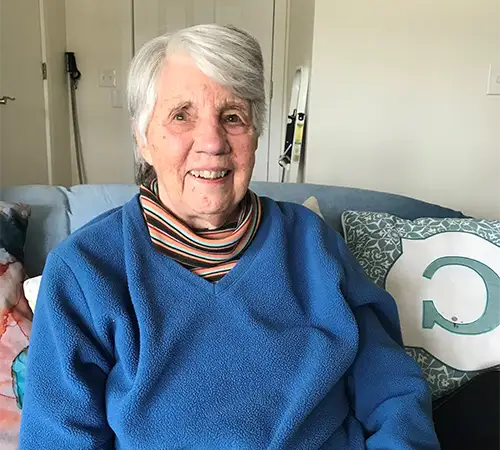Carolyn Baldwin, Conservation Champion

by Sarah McCraw Crow and Kathy Barnes
March 2023 – You may know Carolyn Baldwin’s name from her time as a Five Rivers board member (2008 – 2014), or from her longtime work as a lawyer specializing in environmental law, growth management, and municipal planning. Or from her time on the boards of the NH Historic Preservation Task Force, the NH Historic Resources Council, NH Public Radio, and the New Hampshire Mainstreet Center. But did you know that she was the first woman lawyer in Belknap County, and one of the first 100 women lawyers in the state? For Women’s History Month, here’s a little more about one of our local conservation champions.
Carolyn, her husband Peter, and their three children came to New Hampshire in 1973 from Chicago, where Carolyn had earned a library degree and worked in “special collections” at the University of Chicago library, and Peter taught at U. Chicago’s Meadville Lombard School of Theology. They settled in Gilmanton, on a property on Pancake Hill that Peter’s parents had bought in the 1930s as a summer place.
Peter went to work at New England College, and Carolyn began to look for work. At the University of New Hampshire’s library, she was told that they’d never have a special collections department (six months later she was introduced to the man they hired). So she worked briefly at New Hampshire Historical Society’s library before deciding on a change: “Franklin Pierce Law School was looking for a librarian,” she says, “so I managed to pass the LSAT and went to law school. I had the best of both worlds, working in the library to pay my tuition.”
She graduated and passed the bar in 1977, but getting a law-firm job was another story. “I can’t tell you how many law firms in 1977 said ‘oh we’ll never hire a woman lawyer,’” she notes, about her job search. “I worked with a small firm in Belknap County for a couple of years and did a lot of domestic relations legal work, which I really didn’t like.” But she’d also found her calling—during law school, she’d interned at Lakes Region Planning Commission, and realized that she wanted to work in municipal planning, conservation, and historic preservation—and in 1978 she returned to Franklin Pierce to direct their Environmental Law Clinic.
Four years later, she hung out a shingle, but in the early 1980s, making one’s way as a woman lawyer and solo practitioner was a struggle.
Carolyn remembers the woman banker who took a chance on a young woman lawyer in 1983: “Because I was going out on my own, I had to go to the bank and get a line of credit. The woman at the bank was wonderful, and when I got home, Mr. Philodendron (her now 40-year-old philodendron plant) was there waiting for me, sent by that woman,” Carolyn says. “Whenever I look at this plant, I think of the woman who made it possible for me to get started. Banks back then always asked for a husband’s signature. But this woman didn’t do that, and somehow she was able to take a chance on me.”
For the next 30+ years, Carolyn worked in the Concord area on her own and with several partners, ultimately retiring from BCM Environmental & Land Law (she’s the B in BCM), becoming “of counsel” around 2000.
Even with her full work schedule, Carolyn found time for extensive volunteer work over the decades, primarily in Gilmanton (to name just a few examples, she served on the town’s Select Board from 1995 to 1998, Planning Board from 1982 to 1994, chaired the town’s Conservation Commission from 1974 to 1980, and served on its Zoning Board of Adjustment from 1998 to 2010). She also volunteered with the Gilmanton Land Trust. Founded by fellow Gilmanton resident Tom Howe, the Gilmanton Land Trust’s most visible project is one done in conjunction with Five Rivers – conserving several properties to preserve the iconic views of the Belknap range seen from Frisky Hill on Route 107.
Given Carolyn’s deep involvement with Gilmanton, it’s no wonder that two of her three children chose to live and raise their own children there. (One daughter and her family live in Concord.) “I’m so lucky for someone of my age to have all three of my kids close by,” Carolyn says. “If anyone had told me 50 years ago that my kids would be raising their kids here, I’d never have believed it. My eldest daughter raises pigs and chickens on our Pancake Hill property. My daughter-in-law runs the Gilmanton Historical Society museum and helped create the museum at the Tom Howe barn on Meetinghouse Road. That was a big project of Tom’s, preserving that side of Meetinghouse Pond,” she says. “The retting pond (a pond used by farmers in the 18th century to soak flax straw in order to separate the fibers prior to weaving) there is an example of the connection between history and land conservation.”
“I’ve been very, very lucky, with great people to work with,” she modestly adds. “And I’ve enjoyed it. Great satisfaction in being involved. It takes a community.”



